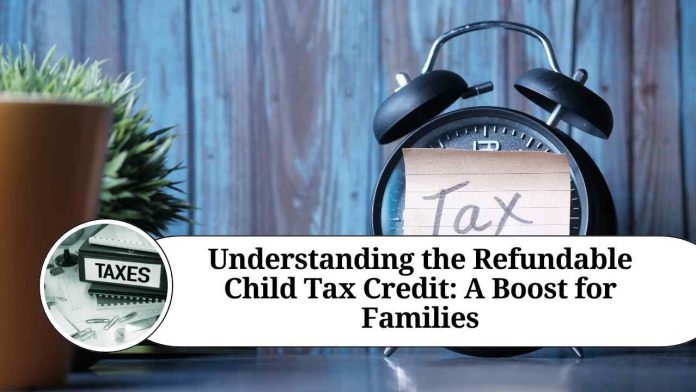Introduction
In a bid to support families and provide financial relief, the government has introduced various measures over the years. One such measure that has gained significant attention is the Refundable Child Tax Credit. Designed to help low- and middle-income families, this credit aims to alleviate the financial burden associated with raising children. In this blog post, we will delve into the details of the Refundable Child Tax Credit and explore how it can make a positive impact on families’ lives.
What is the Refundable Child Tax Credit?
The Refundable Child Tax Credit is a provision within the tax code that offers eligible families a credit for each qualifying child. Unlike non-refundable tax credits, which can only reduce a taxpayer’s liability to zero, the refundable nature of this credit allows families to receive a refund even if their tax liability is already zero. In other words, it can result in a tax refund that exceeds the amount of taxes owed.
Enhancements to the Refundable Child Tax Credit:
The Refundable Child Tax Credit has undergone significant enhancements in recent years. Most notably, the American Rescue Plan Act, passed in March 2021, increased the credit amount and expanded its eligibility criteria. Here are the key enhancements:
- Increased credit amount: The maximum credit amount per child under the age of 6 has been raised from $2,000 to $3,600, and for children aged 6 to 17, it has increased to $3,000. This increase means that eligible families can receive a more substantial financial benefit to support the upbringing of their children.
- Broadened eligibility: The income threshold for the Refundable Child Tax Credit has been expanded, allowing more families to qualify for the credit. Previously, the credit began phasing out for individuals earning $200,000 and married couples filing jointly earning $400,000. Under the new provisions, the phase-out starts at $75,000 for single filers, $112,500 for heads of household, and $150,000 for married couples filing jointly.
- Advance payments: To provide immediate assistance to families, the enhanced Refundable Child Tax Credit is available as advance payments. Instead of waiting to claim the credit during tax filing, eligible families can receive periodic payments throughout the year, starting from July 2021. This helps alleviate financial burdens and provides timely support for families.
Benefits of the Refundable Child Tax Credit:
The Refundable Child Tax Credit has the potential to positively impact families in several ways:
- Financial relief: By increasing the credit amount and expanding eligibility, the government aims to provide families with much-needed financial relief. This additional support can help cover essential expenses related to child care, education, health, and other necessities, ultimately improving the overall well-being of families.
- Reducing child poverty: One of the primary objectives of the Refundable Child Tax Credit is to address child poverty. By providing a higher credit amount and making it refundable, the government aims to lift millions of children out of poverty, providing them with a better chance for a brighter future.
- Stimulating the economy: The increased financial resources in the hands of families can lead to increased spending on goods and services, thereby stimulating the economy. This can have a cascading effect, creating job opportunities and driving economic growth.
Conclusion
The Refundable Child Tax Credit is a valuable provision that acknowledges the financial challenges faced by families in raising children. By increasing the credit amount, broadening eligibility, and introducing advance payments, the government aims to provide much-needed support and alleviate the financial burdens on families.
Other Related Blogs: Section 144B Income Tax Act
Frequently Asked Questions (FAQs)
Q1: What is the Refundable Child Tax Credit?
A1: The Refundable Child Tax Credit is a provision within the tax code that offers eligible families a credit for each qualifying child. Unlike non-refundable tax credits, this credit is refundable, meaning families can receive a refund even if their tax liability is already zero.
Q2: How has the Refundable Child Tax Credit been enhanced?
A2: The Refundable Child Tax Credit has undergone significant enhancements in recent years. The American Rescue Plan Act increased the maximum credit amount per child to $3,600 for children under the age of 6 and $3,000 for children aged 6 to 17. Additionally, the income thresholds for eligibility have been expanded, allowing more families to qualify for the credit.
Q3: Who is eligible for the Refundable Child Tax Credit?
A3: Eligibility for the Refundable Child Tax Credit is based on various factors, including the child’s age, relationship to the taxpayer, and the taxpayer’s income. Generally, families with children under the age of 18 who meet specific income requirements may be eligible for the credit.
Q4: How does the advance payment of the Refundable Child Tax Credit work?
A4: The enhanced Refundable Child Tax Credit is available as advance payments. Eligible families can receive periodic payments throughout the year, starting from July 2021. The amount of the advance payment is based on the information provided on the taxpayer’s most recent tax return.
Q5: Do I need to take any action to receive the advance payments?
A5: If you are eligible for the advance payments, you don’t need to take any action. The IRS will automatically determine your eligibility based on your tax return information. However, it is essential to ensure that your information is up to date to avoid any issues with receiving the payments.
Q6: Can I opt out of receiving the advance payments?
A6: Yes, you can opt-out of receiving the advance payments if you prefer to claim the entire credit when filing your tax return. The IRS has provided an online portal where you can manage your advance payment preferences.
Q7: How will the Refundable Child Tax Credit impact my tax return?
A7: The Refundable Child Tax Credit can significantly impact your tax return. It can help reduce your tax liability or even result in a tax refund that exceeds the amount of taxes owed. The advance payments received throughout the year will be reconciled when you file your tax return.
Q8: Are there any limitations or restrictions to the Refundable Child Tax Credit?
A8: While the Refundable Child Tax Credit provides valuable support, there are some limitations and restrictions. These include income phase-out thresholds, requirements regarding the child’s age and relationship to the taxpayer, and the need to provide accurate information when claiming the credit.
Q9: Can I claim the Refundable Child Tax Credit for adopted children or foster children?
A9: Yes, in most cases, you can claim the Refundable Child Tax Credit for adopted children or foster children who meet the eligibility criteria. It’s important to ensure that you have the necessary documentation to support your claim.
Q10: Where can I get more information about the Refundable Child Tax Credit?
A10: For more information about the Refundable Child Tax Credit, you can visit the official website of the Internal Revenue Service (IRS) or consult a tax professional who can provide guidance based on your specific circumstances.




















